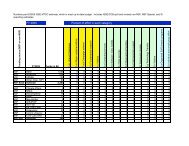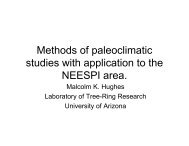Ground Truth Studies Teacher Handbook - Aspen Global Change ...
Ground Truth Studies Teacher Handbook - Aspen Global Change ...
Ground Truth Studies Teacher Handbook - Aspen Global Change ...
Create successful ePaper yourself
Turn your PDF publications into a flip-book with our unique Google optimized e-Paper software.
Just Right: The Goldilocks Effect (continued)<br />
down what they see and what they think is on the<br />
poster. Have them continue until they can identify it.<br />
At that point, they should stop and mark the ground<br />
with chalk. They should then continue approaching<br />
the poster until they are so close they can no longer<br />
tell what it is. At this point, they mark the floor<br />
again. Finally, have them move right up to the poster<br />
and examine some detail of it with the magnifying<br />
glass and record what they see.<br />
3. Students then measure the two distances from the<br />
poster. These distances define the range or “window”<br />
within which their “remote sensors” (eyes) are<br />
capable of gathering the most useful information.<br />
That window might be called the “Goldilocks<br />
Window” — not too hot, not too cold, but just right<br />
— for gathering information about the poster.<br />
Extension<br />
1. Give a slide show or show a video on the possibilities<br />
and limitations of remote sensing and the different<br />
“windows”. A slide set and a video on remote sensing<br />
are available through the <strong>Aspen</strong> <strong>Global</strong> <strong>Change</strong><br />
Institute.<br />
2. Watch the video “Powers of Ten” and discuss the<br />
differences in perspective each power of ten reveals.<br />
(Available through most libraries, or order the VHS<br />
cassette “The Films of Charles & Roy Eames, Volume<br />
One, Powers of Ten” from Pyramid Film and Video,<br />
Box 1048, Santa Monica, CA 90406 / 800-421-2304)<br />
Discussion<br />
1. Your students should discuss what kinds of information<br />
they observed from each of the various distances.<br />
They should try to frame questions that can be<br />
answered only from close up, but not from far away,<br />
vice-versa, and some questions that can be answered<br />
only from a medium distance.<br />
2. You can then explain that when people want to know<br />
something about the Earth, they sometimes take<br />
pictures of it from airplanes and spaceships so they<br />
can get a perspective which is different from the one<br />
they have when looking at it from the ground. This is<br />
just like how your students got different perspectives<br />
on the poster from varying distances. Scientists<br />
gathering data by remote sensing do the same kind of<br />
exercise that your students just did. They figure out<br />
just how close or far away the camera needs to be to<br />
give them the information they want. Using analogies<br />
such as this, young students can begin to understand<br />
the concept of remote sensing and how it is used.<br />
44<br />
© ASPEN GLOBAL CHANGE INSTITUTE 1995 GROUND TRUTH STUDIES


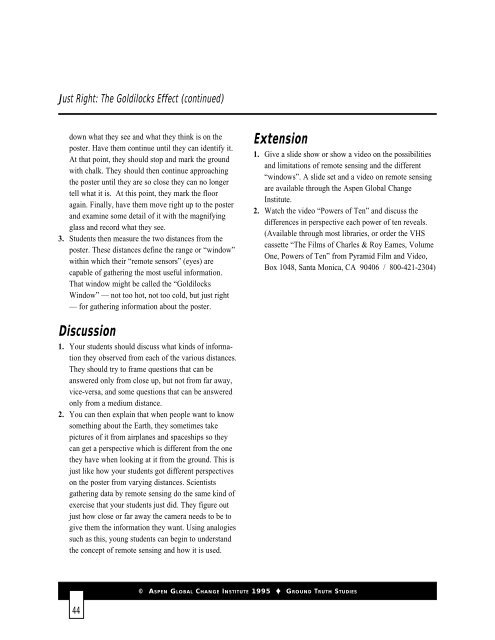
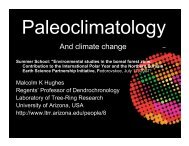

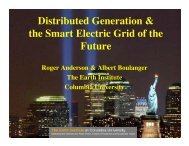
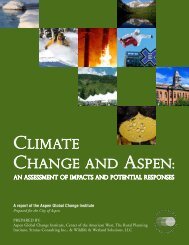

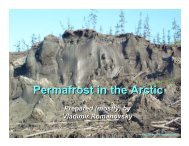
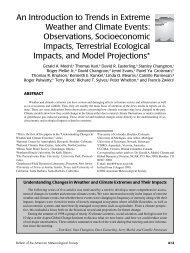
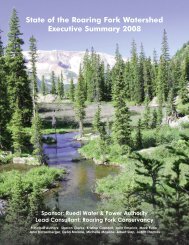
![View Powerpoint Slides [PDF]](https://img.yumpu.com/32486693/1/190x146/view-powerpoint-slides-pdf.jpg?quality=85)
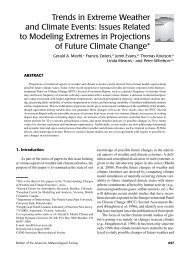

![View Powerpoint Slides [PDF]](https://img.yumpu.com/29411106/1/190x143/view-powerpoint-slides-pdf.jpg?quality=85)
